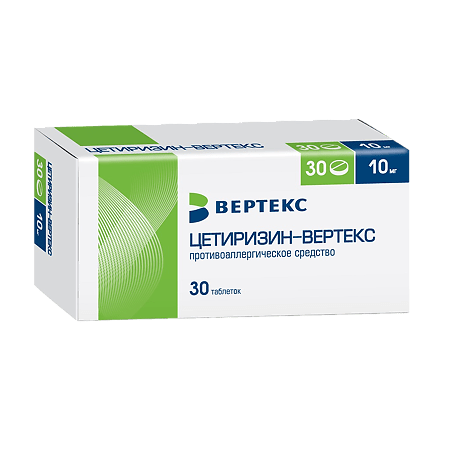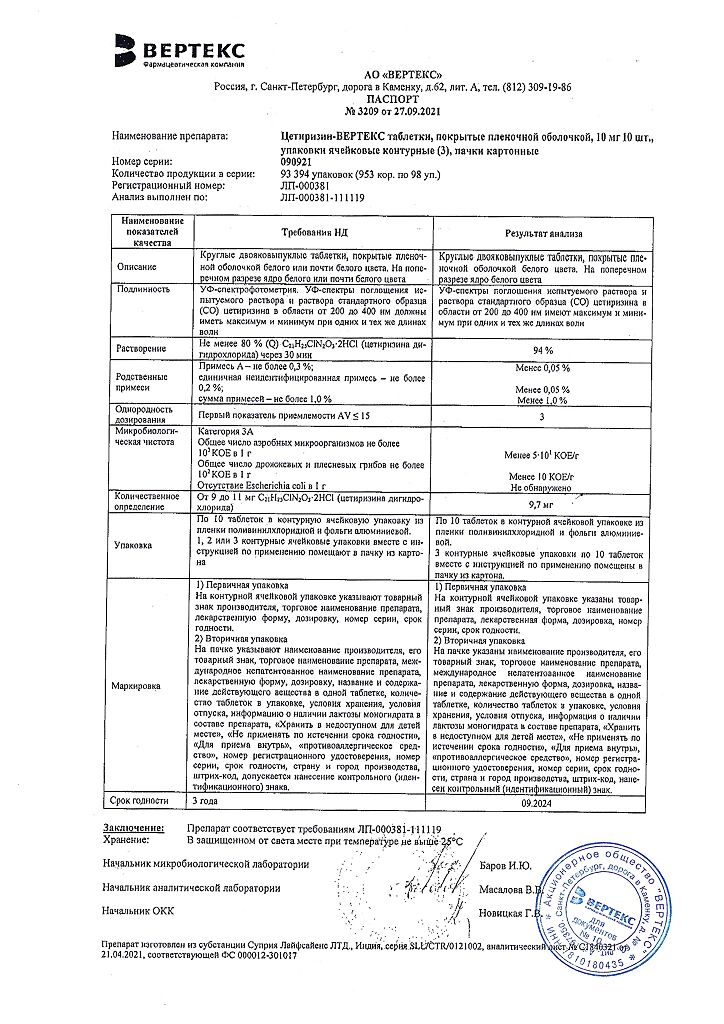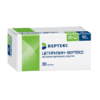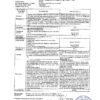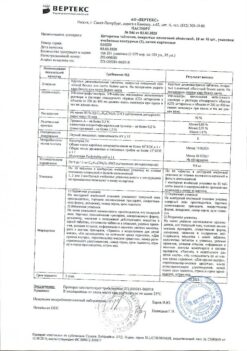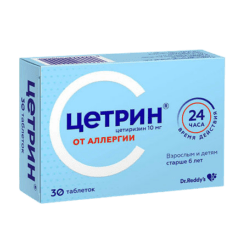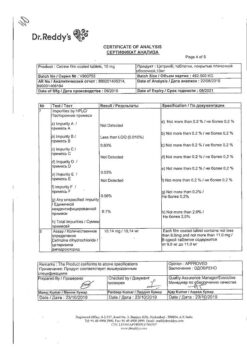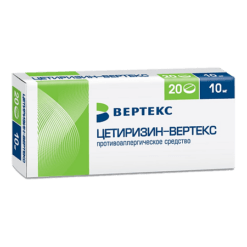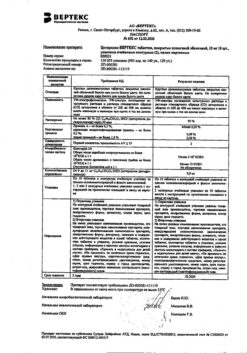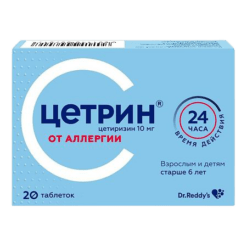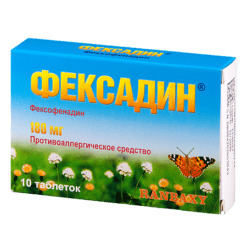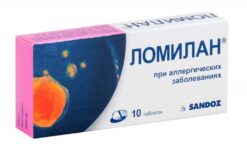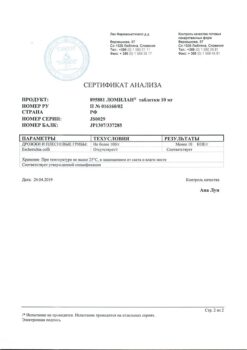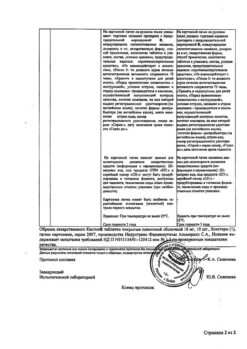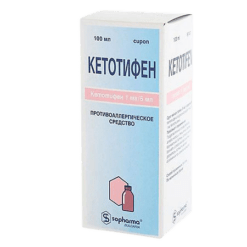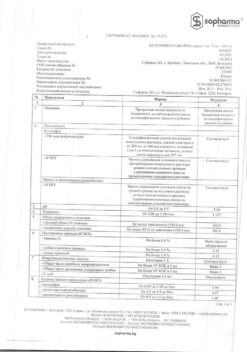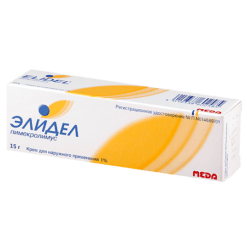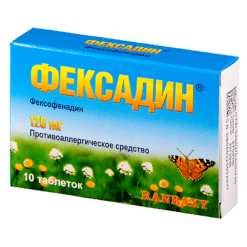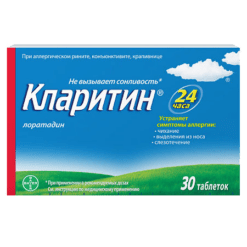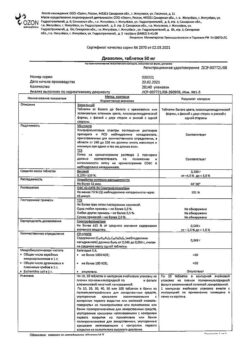No products in the cart.
Description
Pharmacotherapeutic group
Anti-allergic agent – H1-histamine receptor blocker.
ATC code
R06AE07
Pharmacological properties
/p>
Pharmacodynamic properties
Mechanism of action
/p>
Cetirizine, the active ingredient of the drug, is a metabolite of hydroxyzine and has an antihistamine effect with antiallergic action. Cetirizine belongs to the group of competitive histamine antagonists and blocks H1-histamine receptors with little effect on other receptors and has almost no anticholinergic and antiserotonin action.
Cetirizine affects the histamine-dependent stage of immediate allergic reactions and also reduces the migration of eosinophils and limits the release of mediators in delayed-type allergic reactions. It practically does not pass through the blood-brain barrier and therefore is almost incapable of reaching central H1 receptors.
Pharmacodynamics
In studies of the effects of histamine on the skin, the effects of cetirizine at a dose of 10 mg began after 1 hour, peaked from the 2nd to 12th hour, and were still observed at statistically significant levels after 24 hours. In addition to its antihistamine effect, cetirizine also has an anti-inflammatory effect and thus has an effect on the late phase of the allergic reaction:
– At a dose of 10 mg once or twice daily, it inhibits the late phase of eosinophil aggregation in the skin;
– At a dose of 30 mg daily, it inhibits the release of eosinophils into the bronchial alveolar fluid after allergen-induced bronchial constriction;
– Inhibits the kallikrein-induced late inflammatory response;
– Suppresses the expression of inflammatory markers such as ICAM-1 or VCAM-1;
– Inhibits the action of histaminoliberators such as PAF or Substance P.
Pharmacokinetics:
Intake
After oral administration, the drug is rapidly absorbed from the gastrointestinal tract. The pharmacokinetic parameters of cetirizine change linearly when administered in doses from 5 to 60 mg. The equilibrium concentration is reached after 3 days.
The pharmacokinetic profile of cetirizine is similar in adults and children. In children after taking cetirizine in a dose of 5 mg, the concentration of the active substance in the body is the same as in adults after taking 10 mg. In adults after the use of cetirizine in dose of 10 mg the maximum concentration (Cmax) in blood plasma is reached after 1-2 hours and is 350 ng/ml. In children after cetirizine administration in a dose of 5 mg, the maximum concentration (Cmax) in plasma is reached after 1 hour and is 275 ng/ml.
When cetirizine is taken in the form of drops, maximum plasma concentrations are reached at a higher rate.
Distribution
Distribution after administration of 10 mg is 35 liters in adults and plasma protein binding is 93%. In children, the volume of distribution after administration of 5 mg is approximately 17 liters.
A small amount of cetirizine is excreted into breast milk.
Metabolism
In adults, 60% of the dose is excreted unchanged by the kidneys.
Elevation
After administration of 10 mg in adults, the total clearance of cetirizine is 0.60 ml/min/kg; the half-life (T½) is approximately 10 hours. Multiple doses do not alter pharmacokinetic parameters. No cetirizine cumulation was observed when cetirizine was administered in a daily dose of 10 mg for 10 days.
After the end of treatment, plasma levels of cetirizine rapidly fall below detectable limits. Repeated allergy tests can be resumed after 3 days.
Particular patient groups
Elderly patients:
The T½ was 50% higher and the excretion rate was 40% lower in 16 elderly persons when a single dose of 10 mg of cetirizine was given compared with a control group. The decreased clearance of cetirizine in elderly patients is probably due to decreased renal function in this category of patients.
Children:
In children aged 6 to 12 years, 70% of the dose is excreted unchanged by the kidneys. After administration of 5 mg in children, the total clearance of cetirizine is 0.93 ml/min/kg.
The T½ in children from 6 to 12 years is 6 hours, from 2 to 6 years – 5 hours.
Patients with renal insufficiency:
In patients with mild renal impairment (creatinine clearance (CK) > 50 ml/min), pharmacokinetic parameters are similar to those in healthy volunteers with normal renal function.
In patients with moderate renal impairment (CK 30-49 mL/min), T½ is prolonged 3-fold and total clearance is reduced by 70% relative to healthy volunteers with normal renal function.
In patients on hemodialysis (CK < 7 ml/min), oral cetirizine doses of 10 mg decrease total clearance by approximately 70% relative to healthy volunteers with normal renal function, and T½ is prolonged by a factor of 3.
Less than 10% of cetirizine is removed by standard hemodialysis procedures.
Patients with hepatic insufficiency:
In patients with chronic liver disease (hepatocellular, cholestatic, and biliary cirrhosis), a single dose of 10 or 20 mg of cetirizine increases T½ by about 50% and decreases clearance by 40% compared with healthy subjects.
Dose adjustment is necessary only if a patient with hepatic impairment also has concomitant renal impairment.
Indications
Indications
The use of the drug is indicated in adults and children over 6 years of age to alleviate:
– nasal and ocular symptoms of year-round (persistent) and seasonal (intermittent) allergic rhinitis and allergic conjunctivitis, such as itching, sneezing, nasal congestion, rhinorrhea, lacrimation, conjunctival hyperemia;
– symptoms of chronic idiopathic urticaria.
Pharmacological effect
Pharmacological effect
Pharmacotherapeutic group
Antiallergic agent – H1-histamine receptor blocker.
ATX code
R06AE07
Pharmacological properties
Pharmacodynamic properties
Mechanism of action
Cetirizine, the active substance of the drug, is a metabolite of hydroxyzine, has an antihistamine effect with an antiallergic effect. Cetirizine belongs to the group of competitive histamine antagonists and blocks H1-histamine receptors with little effect on other receptors and has virtually no anticholinergic and antiserotonin effects.
Cetirizine has an effect on the histamine-dependent stage of immediate-acting allergic reactions, and also reduces the migration of eosinophils and limits the release of mediators in delayed-type allergic reactions. Almost does not pass the blood-brain barrier and, therefore, is almost unable to reach the central H1 receptors.
Pharmacodynamics
In studies of the effects of histamine on the skin, the effects of cetirizine at a dose of 10 mg began at 1 hour, peaked at 2 to 12 hours, and were still observed at statistically significant levels at 24 hours. In addition to the antihistamine effect, cetirizine also has an anti-inflammatory effect and thereby affects the late phase of the allergic reaction:
– at a dose of 10 mg once or twice a day, inhibits the late phase of eosinophil aggregation in the skin;
– at a dose of 30 mg per day inhibits the excretion of eosinophils into the bronchial alveolar fluid after allergen-induced bronchial constriction;
– inhibits the late inflammatory response caused by kallikrein;
– suppresses the expression of inflammatory markers such as ICAM-1 or VCAM-1;
– inhibits the action of histamine liberators such as PAF or substance P.
Pharmacokinetics:
Suction
After oral administration, the drug is quickly absorbed from the gastrointestinal tract. The pharmacokinetic parameters of cetirizine when used in doses from 5 to 60 mg change linearly. Equilibrium concentration is achieved after 3 days.
The pharmacokinetic profile of cetirizine is similar in adults and children. In children, after taking cetirizine at a dose of 5 mg, the concentration of the active substance in the body is the same as in adults after taking 10 mg. In adults, after taking cetirizine at a dose of 10 mg, the maximum concentration (Cmax) in the blood plasma is reached after 1-2 hours and is 350 ng/ml. In children, after taking cetirizine at a dose of 5 mg, the maximum concentration (Cmax) in the blood plasma is reached after 1 hour and is 275 ng/ml.
When cetirizine is taken in the form of drops, maximum plasma concentrations are achieved at a higher rate.
Distribution
Distribution after taking 10 mg is 35 liters in adults, and binding to plasma proteins is 93%. In children, the volume of distribution after taking 5 mg is approximately 17 liters.
A small amount of cetirizine is excreted into breast milk.
Metabolism
In adults, 60% of the dose is excreted unchanged from the body by the kidneys.
Removal
After taking 10 mg in adults, the total clearance of cetirizine is 0.60 ml/min/kg; The half-life (T½) is approximately 10 hours. Taking multiple doses does not change pharmacokinetic parameters. When taking cetirizine at a daily dose of 10 mg for 10 days, no accumulation of cetirizine was observed.
After the end of treatment, the level of cetirizine in the blood plasma quickly falls below detectable limits. Repeated allergy tests can be resumed after 3 days.
Selected patient groups
Elderly patients:
In 16 elderly individuals, with a single dose of cetirizine 10 mg, T½ was 50% higher and the elimination rate was 40% lower compared to the control group. The decreased clearance of cetirizine in elderly patients is likely due to decreased renal function in this category of patients.
Children:
In children aged 6 to 12 years, 70% of the dose is excreted unchanged from the body by the kidneys. After taking 5 mg in children, the total clearance of cetirizine is 0.93 ml/min/kg.
T½ for children from 6 to 12 years old is 6 hours, from 2 to 6 years old – 5 hours.
Patients with renal failure:
In patients with mild renal failure (creatinine clearance (CC) > 50 ml/min), pharmacokinetic parameters are similar to those in healthy volunteers with normal renal function.
In patients with moderate renal failure (creatinine clearance 30-49 ml/min), T½ is prolonged by 3 times, and total clearance is reduced by 70% relative to healthy volunteers with normal renal function.
In patients on hemodialysis (creatinine clearance <7 ml/min), when cetirizine is taken orally at a dose of 10 mg, the total clearance is reduced by approximately 70% relative to healthy volunteers with normal renal function, and T½ is extended by 3 times.
Less than 10% of cetirizine is removed during standard hemodialysis.
Patients with liver failure:
In patients with chronic liver diseases (hepatocellular, cholestatic and biliary cirrhosis), with a single dose of cetirizine at a dose of 10 or 20 mg, T½ increases by approximately 50% and clearance decreases by 40% compared to healthy subjects.
Dose adjustment is only necessary if the patient with hepatic insufficiency also has concomitant renal insufficiency.
Special instructions
Special instructions
Concomitant use with alcohol and drugs that depress the central nervous system is not recommended.
Impact on the ability to drive vehicles. Wed and fur.:
Active ingredient
Active ingredient
Cetirizine
Composition
Composition
One tablet contains:
Active ingredient:
Cetirizine dihydrochloride – 10.0 mg;
Excipients:
Lactose monohydrate – 70.0 mg;
Microcrystalline cellulose – 34.0 mg;
Crospovidone – 3.6 mg;
Magnesium stearate – 1.2 mg;
Colloidal silicon dioxide – 1.2 mg;
Film casing:
[hypromellose – 2.40 mg, talc – 0.80 mg, titanium dioxide – 0.44 mg, macrogol 4000 (polyethylene glycol 4000) – 0.36 mg] or [dry film coating mixture containing hypromellose (60%), talc (20%), titanium dioxide (11%), macrogol 4000 (polyethylene glycol 4000) (9%)] – 4.0 mg.
Pregnancy
Pregnancy
Pregnancy
Data on the use of cetirizine during pregnancy are limited (300 – 1000 pregnancy outcomes). However, no cases of developmental defects, embryonic or neonatal toxicity with a clear cause-and-effect relationship were identified.
Experimental studies on animals have not revealed any direct or indirect adverse effects of cetirizine on the developing fetus (including in the postnatal period), pregnancy and childbirth.
During pregnancy, cetirizine can be prescribed after consultation with a doctor, if the expected benefit to the mother outweighs the potential risk to the fetus.
Breastfeeding period
Cetirizine should not be used during breastfeeding, because Cetirizine is excreted in breast milk in amounts ranging from 25% to 90% of the plasma concentration, depending on the time of sampling after taking the drug. Adverse reactions associated with cetirizine may occur in infants.
During breastfeeding, it is used after consultation with a doctor, if the expected benefit to the mother outweighs the potential risk to the child.
Fertility
Available data on the effects on human fertility are limited, but no adverse effects on fertility have been identified in animal studies.
Before using the drug, if you are pregnant, or think you might be pregnant, or are planning a pregnancy, you should consult your doctor.
Contraindications
Contraindications
– hypersensitivity to cetirizine, hydroxyzine or other piperazine derivatives, as well as any other components of the drug;
– moderate, severe and end-stage renal failure (creatinine clearance <50 ml/min) (for this dosage);
– children under 6 years of age (for this dosage form);
– hereditary lactose intolerance, lactase deficiency, glucose-galactose malabsorption syndrome.
With caution
– elderly patients (with an age-related decrease in glomerular filtration);
– epilepsy and patients with increased convulsive readiness;
– patients with predisposing factors to urinary retention (see section “Special instructions”);
– when used simultaneously with alcohol (see section “Interaction with other drugs”);
– pregnancy;
– period of breastfeeding.
Side Effects
Side Effects
The drug is usually well tolerated. Side effects occur rarely and are transient.
From the digestive system: dry mouth, dyspepsia.
From the nervous system: dizziness headache drowsiness fatigue agitation migraine.
Allergic reactions: angioedema, skin rashes, itching, urticaria.
Interaction
Interaction
Combined use with theophylline (400 mg/day) leads to a decrease in the total clearance of cetirizine (theophylline kinetics does not change).
Myelotoxic drugs increase the manifestations of hematotoxicity of the drug.
No clinically significant interactions were found with other drugs (pseudoephedrine cimetidine ketoconazole erythromycin azithromycin diazepam glipizide).
Overdose
Overdose
Symptoms
Symptoms observed after apparent overdose of cetirizine affected the central nervous system or were associated with a possible anticholinergic effect.
Symptoms that were observed after taking at least five times the recommended daily dose included the following: confusion, diarrhea, fatigue, headache, malaise, mydriasis, itching, restlessness, sedation, somnolence, stupor, tachycardia, tremor, urinary retention.
Treatment
There is no specific antidote. In case of overdose, symptomatic or supportive treatment is recommended. Gastric lavage and/or activated charcoal may be effective if the overdose is recent. Cetirizine is partially eliminated by dialysis.
Storage conditions
Storage conditions
Store in a place protected from light at a temperature not exceeding 25 ºС.
Keep out of the reach of children.
Shelf life
Shelf life
3 years.
Do not use after expiration date.
Manufacturer
Manufacturer
Vertex, Russia
Additional information
| Shelf life | 3 years. Do not use after the expiration date. |
|---|---|
| Conditions of storage | Store in a light-protected place at a temperature not exceeding 25 ºC. Store out of the reach of children. |
| Manufacturer | Vertex, Russia |
| Medication form | pills |
| Brand | Vertex |
Other forms…
Related products
Buy Cetirizine-Vertex, 10 mg 30 pcs with delivery to USA, UK, Europe and over 120 other countries.

